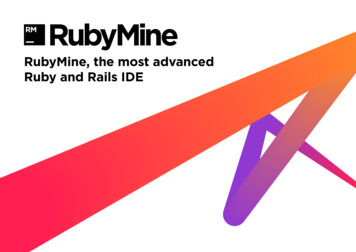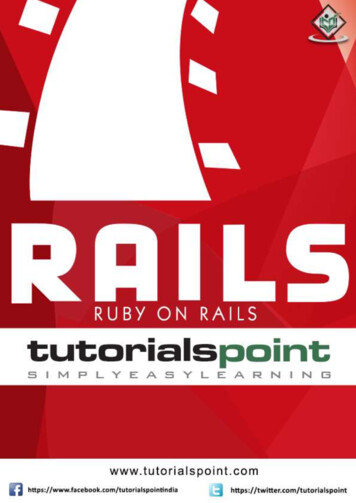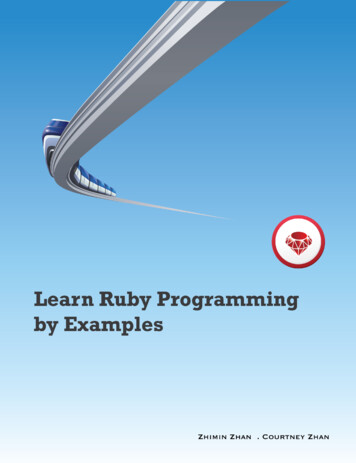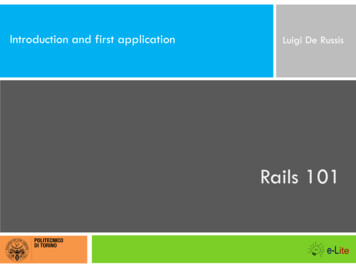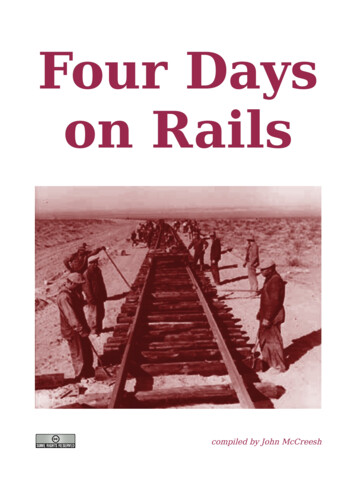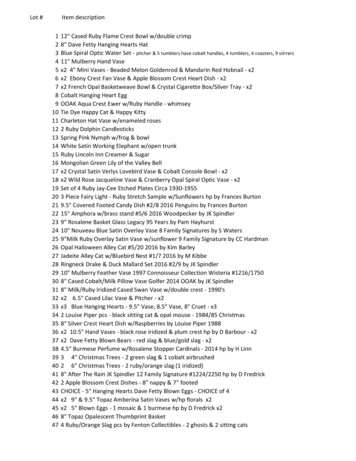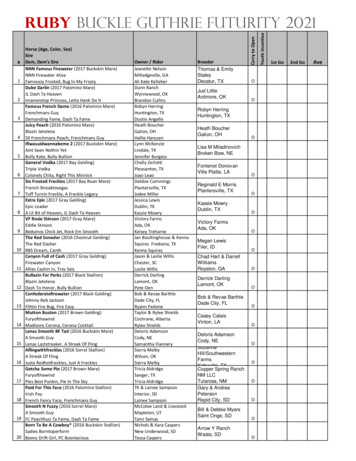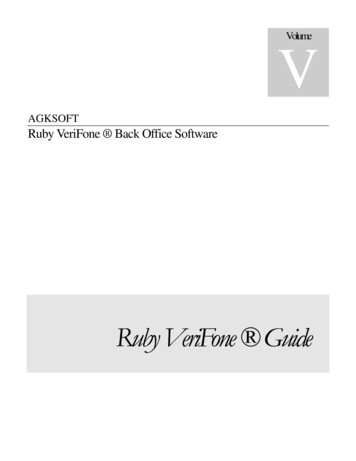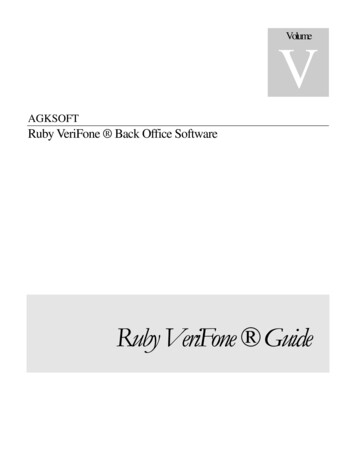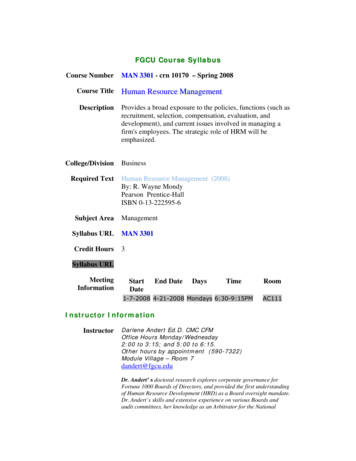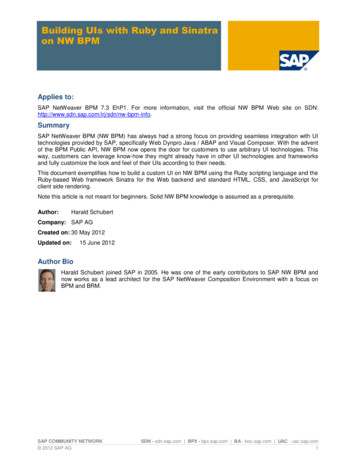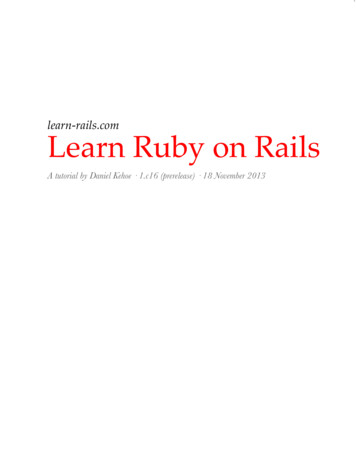
Transcription
1learn-rails.comLearn Ruby on RailsA tutorial by Daniel Kehoe · 1.c16 (prerelease) · 18 November 2013
2Contents1.About the Book . 32.Introduction . 43.Concepts. 94.Get Help When You Need It . 155.Plan Your Product . 196.Manage Your Project . 267.Accounts You May Need . 288.Get Started . 319.Create the Application . 3910.The Parking Structure . 4711.Time Travel with Git . 5112.Gems . 6113.Configure . 7114.Static Pages and Routing. 7615.Request and Response . 7916.Dynamic Home Page . 8817.Troubleshoot . 9818.Just Enough Ruby . 11019.Layout and Views . 13220.Front-End Framework . 15521.Add Pages. 17622.Contact Form . 18123.Spreadsheet Connection . 20124.Send Mail . 20725.Mailing List . 21426.Deploy . 22327.Analytics . 23528.Rails Challenges. 24229.Credits and Comments. 247
3Chapter 1About the BookI hope you will agree that this is the “best book for Rails beginners.”Over 900 people have downloaded an advance edition of this book. I’ve incorporated manyof their suggestions for improvements.Over 600 people have contributed to the Kickstarter campaign to launch the book withpledges ranging from 9 to 350. Launching the book would not be possible without supportfrom Kickstarter contributors.The Kickstarter campaign ends on Saturday, November 30th, at 5pm US Pacific Time.If you agree that the book is valuable, I hope you will contribute to the Kickstarter campaign.Click here: Make a pledge to the Kickstarter campaignIn addition to contributing to the Kickstarter campaign, please help get the word out: Write a blog post about the book post the link on Twitter post the link on Facebook post the link on Google Mentioning the book online is important.Here’s the link to the book: nk you for your support.
4Chapter 2IntroductionWelcome. This tutorial is a first step on your path to learn Ruby on Rails.You’ll learn key concepts so you’ll have a solid foundation for continued study. You’ll builda working web application so you’ll gain hands-on experience. Along the way, you’llpractice the techniques used by professional Rails developers and you’ll understand whyRails has become a popular choice for web development.
5Is It for You?You don’t need to be a programmer to succeed with this tutorial. You’ll get comfortable withthe Ruby programming language and the Unix command line interface as you build a Railsapplication.This tutorial is ideal if you are: a student a startup founder making a career changeDoes this sound like you? Readers who work in social media or graphic design say thistutorial is a good way to get introduced to programming. Others who previously builtsimple websites using HTML, or used applications such as WordPress, found they couldeasily progress to building websites with Rails. Programmers with experience in languagessuch as PHP or Java found this tutorial to be a good way to get started with the Railsframework.On the other hand, if you’ve never encountered HTML, it is best to start elsewhere with an“Introduction to Web Design” course or online tutorial.WarningsThis is two books in one. At the core is a hands-on tutorial that will lead you through thecode needed to build a real-world web application. I thoroughly explain the code you’ll needto write a Rails application. Before you start coding, I explain the culture and practices of theRails community. If you’re in a hurry to start coding, jump right now to Chapter 7, “GetStarted.” But I urge you to read the preliminary chapters first. They’ll give you the contextyou need to become a skilled Rails developer. Many readers have told me the concepts at thebeginning of the book provide a grounding they haven’t found in any other tutorial.The tutorial is designed to unfold in steps, one section leading to another. You can use thebook as a reference, skipping around without reading from beginning to end, but you’llactually waste time as you try to pick up the pieces you missed.The chapters are densely packed with links to background reading. If you click every link,you’ll be a well-informed student, but you may never finish the book! It’s up to you tomaster your curiosity. Follow the links only when you want to dive deeper.There is rich satisfaction in building something and making it run. But programming can befrustrating and Rails isn’t easy for beginners. Before you get to the reward, you’ll encountersetbacks. If at times you’re ready to quit, jump to the chapter titled “Rails Challenges”at the
6end of the book. It describes many of the problems learners encounter. I’ve written it toaddress your concerns when learning Rails becomes difficult and frustrating.It’s best to work through the book from start to end, allowing enough time to read theintroductory chapters and then building the application. That means you should allow timeto read the book before you start a new job or join a developer bootcamp. Really!What To ExpectYou can read the book and complete the tutorial in one long weekend, though it will takeconcentration and stamina. If you work through the book over a longer timespan, try towork in uninterrupted blocks of two hours or more for reading and coding, as it takes timeto focus and concentrate.When you’ve completed this tutorial, you will be ready for more advanced self-study,including other tutorials from the RailsApps project, textbook introductions to Rails, orworkshops and developer bootcamps that provide intensive training in Ruby on Rails. Othercurriculums often skip the basics. With this tutorial you’ll have a solid grounding in keyconcepts; you won’t feel overwhelmed or frustrated as you continue your studies.This tutorial is good preparation for: advanced tutorials from the RailsApps Project textbooks such as Michael Hartl’s Ruby on Rails Tutorial introductory workshops from RailsBridge or Rails Girls intensive training with immersive code campsWe are blessed with many textbooks, workshops, and classroom programs that teach Rubyon Rails. I believe this book is unique in covering the basics while introducing the tools andtechniques of professional Rails development.The RailsApps ProjectThis book is the foundation for a series of tutorials that accompany example applicationsfrom the RailsApps project.Tutorials from @rails apps take you on a guided path starting with absolute basics (thistutorial). You’ll progress to intermediate-level tutorials and soon be using the RailsApps indepth guides for professional Rails developers.It is important to feel satisfaction and accomplishment as you learn. That’s why each tutorialintroduces Rails in stages. With each tutorial you will build a real-world Rails application.The finished product confirms your accomplishment; you’ll feel genuine satisfaction as you
7deploy your Rails application. Hands-on learning with real Rails applications is the key toabsorbing and retaining knowledge.The applications you’ll build in the tutorials are not classroom exercises. The primarypurpose of the RailsApps project is to provide starter applications for Rails developers.You’ll build real applications that you can customize and adapt for your startup, at your job,or for clients.Hundreds of developers use the RailsApps example applications, report problems as theyarise, and propose solutions. Rails changes frequently; each application is known to workand serves as your personal “reference implementation” so you can stay up to date.Maintenance and development of the RailsApps applications is supported by subscriptionsto the RailsApps tutorials.The ApplicationWe’ll build a basic web application that can be used by a typical small business. The websitewill include a home page, “about” page, contact form, and option to sign up for a mailinglist. You’ll also learn how to collect data from a form and save it to a spreadsheet on GoogleDrive.You’ll find the complete learn-rails application on GitHub. It is a working application that ismaintained by a team of experienced developers so you can always check the “referenceimplementation” if you have problems.A Note to Reviewers and TeachersThis book approaches the subject differently than most introductions to Rails. It introducesconcepts of product planning, project management, and website analytics to placedevelopment within a larger context of product development and marketing. In introducingRails, rather than show the student how to use scaffolding, it introduces the model-viewcontroller design pattern by creating the components manually. The tutorial recommendstest-driven development, but doesn’t show it, simply because I’ve found TDD can’t beadequately covered in a basic introduction. Lastly, though every other Rails tutorial showshow to use a database, this book doesn’t, because I want the book to be a short introductionand I believe the basic principles of a web application stand out more clearly without addinga database to the application. Though this tutorial is not a typical Rails introduction, I hopeyou’ll agree that it does a good job in preparing Rails beginners for continued study, whetherit is developer bootcamp or more advanced books.Using the Book in the ClassroomIf you’ve organized a workshop, course, or code camp, and would like to assign the book asrequired reading, contact me at daniel@danielkehoe.com to arrange access to the book for
8your students. The book is available at no charge to students enrolled in free workshops orclasses, thanks to generous gifts from prominent members of the Rails community.
9Chapter 3ConceptsThis chapter provides the background, or “big picture,” you will need to understand Rails.This chapter is excerpted from an in-depth article What is Ruby on Rails? For a deeperunderstanding of Rails, including background on the guiding principles of Rails, and reasonsfor its popularity, read the article for a complete introduction.Here are the key concepts you’ll need to know before you try to use Rails.How the Web WorksWe start with absolute basics, as promised.When you “visit a website on the Internet” you use a web browser such as Safari, Chrome,Firefox, or Internet Explorer.Web browsers are applications (software programs) that work by reading files.Compare a word processing program with a web browser. Both word processing programs andweb browsers read files. Microsoft Word reads files that are stored on your computer todisplay documents. A web browser retrieves files from remote computers called servers todisplay web pages. Knowing that everything comes from files will help you build a webapplication.A web browser uses four kinds of files to display web pages: HTML – structure (layout) and content (text) CSS – stylesheets to set visual appearance JavaScript – programming to alter the page ImagesAt a minimum, a web page requires an HTML file. If a web browser receives just an HTMLfile, it will display text, with default styles applied by the browser.If the page is always the same, every time it is displayed by the web browser, we say it isstatic. Webmasters don’t need software such as Rails to deliver static documents; they justcreate files for delivery by an ordinary web server program.
10Static websites are ideal for particle physics papers (which was the original use of the WorldWide Web). But most sites on the web, especially those that allow a user to sign in, postcomments, or order products and services, generate web pages dynamically.Dynamic websites often combine web pages with information from a database. A databasestores information such as a user’s name, comments, Facebook likes, advertisements, or anyother repetitive, structured data. A database query can provide a selection of data thatcustomizes a webpage for a particular user or changes the web page so it varies with eachvisit.Dynamic websites use a programming language such as Ruby to assemble HTML, CSS, andJavaScript files on the fly from component files or a database. A software program written inRuby and organized using the Rails development framework is a Rails web application. A webserver program that runs Rails applications to generate dynamic web pages is an applicationserver (but usually we just call it a web server).Software such as Rails can access a database, combining the results of a database query withstatic content to be delivered to a web browser as HTML, CSS, and JavaScript files. Keep inmind that the web browser only receives ordinary HTML, CSS, and JavaScript files; the filesthemselves are assembled dynamically by the Rails application running on the server.Even if you are not going to use a database, there are other good reasons to generate awebsite using a programming language. For example, if you are creating several web pages,it often makes sense to assemble an HTML file from smaller components. For example, youmight make a small file that will be included on every page to make a footer (Rails calls these“partials”). Just as importantly, if you are using Rails, you can add features to your websitewith code that has been developed and tested by other people so you don’t have to buildeverything yourself.The widespread practice of sharing code with other developers for free, and collaboratingwith strangers to build applications or tools, is known as open source software development.Rails is at the heart of a vibrant open source development community, which means youleverage the work of tens of thousands of skilled developers when you build a Railsapplication. When Ruby code is packaged up for others to share, the package is called a gem.The name is apt because shared code is valuable.Ruby is a programming language; Rails is a development framework. That means Rails is aset of structures and conventions for building a web application using the Ruby language. Railsis also a library or collection of gems that developers use as the core of any Rails webapplication. By using Rails, you get well-tested code that implements many of the mostneeded features of a dynamic website.With Rails, you will be using shared standard practices that make it easier to collaboratewith others and maintain your application. As an example, consider the code that is used toaccess a database. Using Ruby without the Rails framework, or using another language suchas PHP, you could mix the complex programming code that accesses the database with thecode that generates HTML. With the insight of years of developers’ collective experience inmaintaining and debugging such code, Rails provides a library of code that segregates
11database access from the code that displays pages, enforcing separation of concerns, andmaking more modular, maintainable programs.In a nutshell, that’s how the web works, and why Rails is useful.For a history of Rails, and an explanation of why it is popular, see the article What is Rubyon Rails?JavaScript and RubyJavaScript and Ruby are both general-purpose programming languages.Ruby is the programming language you’ll use when creating web applications that run onyour local computer or a remote server using the Rails web application developmentframework.JavaScript is the programming language that controls every web browser. The companiesthat build web browsers (Google, Apple, Microsoft, Mozilla, and others) agreed to useJavaScript as the standard browser programming language. You might imagine analternative universe in which Ruby was the browser programming language; then youwould only have to learn one language for front-end and back-end programming. That’s notthe real world; plus it would be boring, as learning more than one language makes ussmarter and better programmers.Though most of the code in Rails applications is written in Ruby, developers add JavaScriptto Rails applications to implement features such as browser-based visual effects and userinteraction.There is another universe where JavaScript is used on servers to run web applications.System administrators can install the Node.js code library to enable servers to run JavaScript.Server-side JavaScript web application frameworks are available, such as Express andMeteor, but none are as popular as Ruby on Rails.What is Rails?So far, I’ve defined Rails in two ways: as structures and conventions for building a webapplication, and as a library or collection of code.To really understand Rails, and succeed in building Rails applications, we need to considerRails from six other perspectives. Like six blind men encountering an elephant, it can bedifficult to understand Rails unless you look at it from multiple points of view.Here are six different ways of looking at Rails, summarized from the article What is Ruby onRails?
12From the perspective of the web browserbrowser, Rails is simply a program that generates HTML,CSS, and JavaScript files. These files are generated dynamically. You can’t see the files on theserver side but you can view these files by using the web developer tools that are built in toevery browser. Later you’ll examine these files when you learn to troubleshoot a Railsapplication.From the perspective of a programmerprogrammer, Rails is a set of files organized with a specificstructure. The structure is the same for every Rails application; this commonality is whatmakes it easy to collaborate with other Rails developers. We use text editors to edit these filesto make a web application.From the perspective of a software architectarchitect, Rails is a structure of abstractions that enableprogrammers to collaborate and organize their code. Thinking in abstractions means wegroup things in categories and analyze relationships. Conceptual categories andrelationships can be made “real” in code. Software programs are built of “concepts madereal” that are the moving parts of a software machine. To a software architect, classes are thebasic parts of a software machine. A class can represent something in the physical world as acollection of various attributes or properties (for example, a User with a name, password,and email address). Or a class can describe another abstraction, such as a Number, withattributes such as quantity, and behavior, such as “can be added and subtracted.” You’ll geta better grasp of classes in the chapter, “Just Enough Ruby.”To a software architect, Rails is a pre-defined set of classes that are organized into a higherlevel of abstraction known as an API, or application programming interface. The Rails API isorganized to conform to certain widely known software design patterns. You’ll becomefamiliar with these abstractions as you build a Rails application. Later in the tutorial, we’lllearn about the model–view–controller design pattern. As a beginner, you will see the MVCdesign pattern reflected in the file structure of a Rails application.We can look at Rails from the perspective of a gem hunterhunter. Rails is popular becausedevelopers have written and shared many software libraries (RubyGems, or “gems”) thatprovide useful features for building websites. We can think of a Rails application as acollection of gems that provide basic functionality, plus custom code that adds uniquefeatures for a particular website. Some gems are required by every Rails application. Forexample, database adaptors enable Rails to connect to databases. Other gems are used tomake development easier, for example, gems for testing that help programmers find bugs.Still other gems add functionality to the website, such as gems for logging in users orprocessing credit cards. Knowing what gems to use, and why, is an important aspect oflearning Rails. This tutorial will show you how to build a web application using some of themost commonly used gems.We can also look at Rails from the perspective of a time traveler in order to understand theimportance of software version control. Specifically, we use the Git revision control system torecord a series of snapshots of your project’s filesystem. Git makes it easy to back up andrecover files; more importantly, Git lets you make exploratory changes, trying out code youmay decide to discard, without disturbing work you’ve done earlier. You can use Git withGitHub, a popular “social coding” website, for remote backup of your projects andcommunity collaboration. Git can keep multiple versions (“branches”) of your local code in
13sync with a remote GitHub repository, making it possible to collaborate with others on opensource or proprietary projects. Strictly speaking, Git and GitHub are not part of Rails (theyare tools that can be used on any development project). And there are several other versioncontrol systems that are used in open source development. But a professional Railsdeveloper uses Git and GitHub constantly on any real-world Rails project. Rails and thegems that go into a complex web application would not exist without Git and GitHub.Finally, we can consider a Rails application from the perspective of a testertester. Software testingis part of Rails culture; Rails is the first web development platform to make testing anintegrated part of development. Before Rails, automated testing was rarely part of webdevelopment. A web application would be tested by users and (maybe) a QA team. Ifautomated tests were used, the tests were often written after the web application was largelycomplete. Rails introduced the discipline of Test-Driven Development (TDD) to the widerweb development community. With TDD, tests are written before any implementationcoding. It may seem odd to write tests first, but for a skilled TDD practitioner, it bringscoherence to the programming process. First, the developer will give thought to what needsto be accomplished and think through alternatives and edge cases. Second, the developerwill have complete test coverage for the project. With good test coverage, it is easier torefactor, rearranging code to be more elegant or efficient. Running a test suite afterrefactoring provides assurance that nothing inadvertently broke after the changes.TDD is seen as a necessary skill of an experienced Rails developer. Because this is a tutorialfor beginners, it will not introduce you to techniques of Test-Driven Development. As youwork through more advanced tutorials, you’ll be introduced to Test-Driven Development.StacksTo understand Rails from the perspective of a professional Rails developer, you’ll need tograsp the idea of a technology stack and recognize that Rails can have more than one stack.A technology stack is a set of technologies or software libraries that are used to develop anapplication or deliver web pages. “Stack” is a term that is used loosely and descriptively.There is no organization that sets the rules about what goes into a stack. As a technologist,your choice of stack reflects your experience, values, and personal preference, just likereligion or favorite beverage.For example, Mark Zuckerberg developed Facebook in 2004 using the LAMP applicationstack: Linux (operating system) Apache (web server) MySQL (database) PHP (programming language)For this tutorial, your application stack will be:
14 Mac OS X, Linux, or Windows WEBrick (web server) SQLite (database) Ruby on Rails (language and framework)Sometimes when we talk about a stack, we only care about part of a larger stack. Forexample, a Rails stack includes the gems we choose to add features to a website or makedevelopment easier. When we select the gems we’ll use for a Rails application, we’rechoosing a stack.Sometimes the choice of components is driven by the requirements of an application. Atother times, the stack is a matter of personal preference. Just as craftsmen and aficionadosdebate the merits of favorite tools and techniques in any profession, Rails developers avidlydispute what’s the best Rails stack for development.The company 37signals, where the creator of Rails works, uses this Rails stack: ERB for view templates MySQL for databases MiniTest for testingIt is not important (at this point) to know what the acronyms mean (we’ll learn later).Another stack is more popular among Rails developers: Haml for view templates PostgreSQL for databases Rspec for testingWe’ll learn later what the terms mean. For now, just recognize that parts of the Railsframework can be swapped out, just like making substitutions when you order from a menuat a restaurant.You can learn much about Rails by following the experts’ debates about the merits of afavorite stack. The debates are a source of much innovation and improvement for the Railsframework. In the end, the power of the crowd prevails; usually the best components in theRails stack are the most popular.The proliferation of choices for the Rails stack can make learning difficult, particularlybecause the components used by many leading Rails developers are not the componentsused in many beginner tutorials. In this tutorial, we stick to solid ground where there is nodebate. In more advanced tutorials, we’ll explore stack choices and choose components thatare most often used by professional developers.
15Chapter 4Get Help When You Need ItI’m often asked, “Where’s the Rails manual?” There isn’t one. No single document tells youhow to use Rails. Instead, there’s a wealth of documentation that describes various aspects ofRails. You won’t need any other documentation to complete this tutorial but I’d like tosuggest some resources that will be helpful as you go deeper in your study of Rails.Getting HelpFirst of all, what to do when you get stuck?“Google it,” of course. But here’s a trick to keep in mind.Google has options under “Search tools” to show only recent results from the past year. Useit to filter out stale advice that pertains only to older versions of Rails.Stack Overflow is as important as Google for finding answers to programming problems.Stack Overflow answers are often included in Google search results, but you can go directlyto Stack Overflow to search for answers to your questions. Like Google, answers from StackOverflow are helpful if you check carefully to make sure the answers are recent. Also be sureto compare answers to similar questions; the most popular answer is not always the correctanswer to your particular problem.Rails Hotline is a free telephone hotline for Rails questions staffed by volunteers. You’ll needto carefully think about and describe your problem but sometimes there’s no better help thana live expert.ReferencesIn addition to the resources listed here, the RailsApps project offers a list of top resources forRuby and Rails, including books and blogs.If you feel overwhelmed by all the links, remember that you can use this book to build thetutorial application without any additional resources. Right now, it’s important to knowadditional help is available when you need it.Here are suggestions for the most important additional references.
16RailsGuidesThe Rails Guides are Rails’s official documentation, written for intermediate-leveldevelopers who already have experience writing web applications. The Rails Guides are anexcellent reference if you want to check the correct syntax for Rails code. You’ll be able to usethe Rails Guides after completing this tutorial.CheatsheetsTobias Pfeiffer has created a useful Rails Beginner Cheat Sheet that provides a goodoverview of Rails syntax and commands.API DocumentationThe API documentation for Ruby and Rails shows every class and method. These areextremely technical documents (the only thing more technical is reading the source codeitself). The documents offer very little help for beginners, as each class and method isconsidered in isolation, but there are times when checking the API documentation is the onlyway to know for certain how something works. Rails Documentation – official API docs Rails Searchable API Doc – alternative interface for the API docs apidock.com/rails – Rails API docs with usage notes apidock.com/ruby – Ruby API docs with usage notesStaying Up-to-DateRails changes frequently and its community is very active. Changes to Rails, expert blogarticles, and new gems can impact your projects, even if you don’t work full-time as a Railsdeveloper. Consequently, I urge you to stay up-to-date with news from the community.The best source of news is Peter Cooper’s Ruby Weekly email newsletter. It arrives eachThursday and it is free. For more frequent news, check Peter Cooper’s RubyFlow site whichlists new blog posts from Rails developers each day.If you like podcasts, check out Ruby Rogues and Envy Labs’s Ruby5.Meetups, Hack Nights, and WorkshopsI’d like to urge you to find ways you can work with others who are learning Rails. Peersupport is really important when you face a challenge and want to overcome obstacles.
17Most large urban areas have meetups or user group meetings for Rails developers. TryMeetup.com or google “ruby rails (my city)”. The community of Rails developers is friendlyand eager to help beginners. If you are near a Rails meetup, it is
Learn Ruby on Rails A tutorial by Daniel Kehoe · 1.c16 (prerelease) · 18 November 2013 lear
